What’s the rarest bird we’ve seen at Montrose Basin?
It’s a question we’re often asked at Montrose Basin Visitor Centre and not one that’s easy to answer – it’s affected by the passage of time, the location, and seasons. The answer is also, invariably, subject to personal bias and opinion. (Everyone has his or her favourite!).
For example, many people would consider kingfishers rare, but that’s more because they’re generally so elusive. We wouldn’t describe them as ‘rare’ here, with our regular sightings throughout autumn and winter.
So, we thought we’d ask Visitor Centre staff and volunteers what their most memorable or ‘rarest’ sighting has been.
Out of Africa – the Eurasian Hoopoe
One of the most recent rarities that paid a visit to Montrose Basin was a hoopoe. On 16th November 2018, the beautiful thrush-sized bird usually seen pecking about grassy areas in Africa and the Mediterranean, was spotted on the shoreline next to Montrose railway station. It was the first record for Montrose Basin and attracted quite a bit of attention from birdwatchers and locals. It was very content feeding on insects by the Basin’s shoreline. Hoopoes sometimes overshoot their southern European destinations when migrating north from Africa, and between 5 and 20 hoopoes turn up in Scotland every year. So we were lucky that this particular hoopoe’s GPS hadn’t been calibrated!
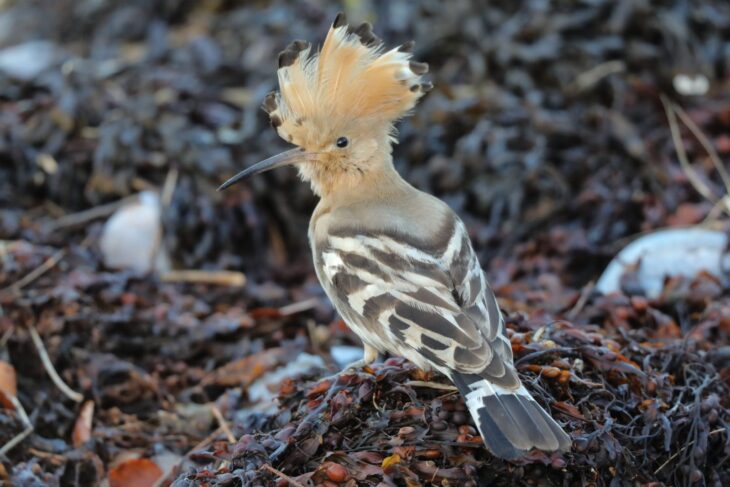
Simon, Strachan and the Snow Goose
You may remember that last October, BBC’s Autumwatch filmed a segment about following the pink-footed geese at Montrose Basin as they leave in the morning to feed in stubble fields. Simon Ritchie, one of our Teacher Naturalists, and Gus Routledge had the enviable task of showing Michaela Strachan around the local area filming gaggles of geese. Simon, always up for the challenge of spotting a rarity or two, was ecstatic when he managed to spot a snow goose in amongst the tens of thousands of pink-footed geese on the Basin’s mudflats.
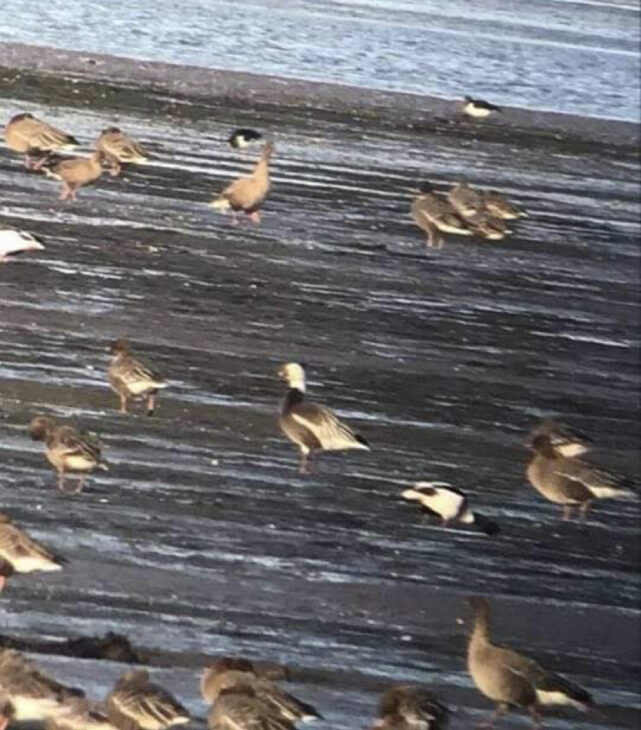
A Turn-up for the Books
In April last year, one of our Volunteers, Andy Glaysher, spotted three rather rare visitors on the mudflats; avocets! This distinctive black and white wader with an upturned bill is usually associated with estuaries in the south of the UK. To see three at Montrose Basin was a real treat. Andy said about his sighting “I was over the moon with this find as it’s the first time I found something rare on my survey patch myself, rather than viewing something someone else had already spotted.”
Fun fact – Montrose Basin remains the record-holder for the Scottish location that has held an avocet for the longest period of time.
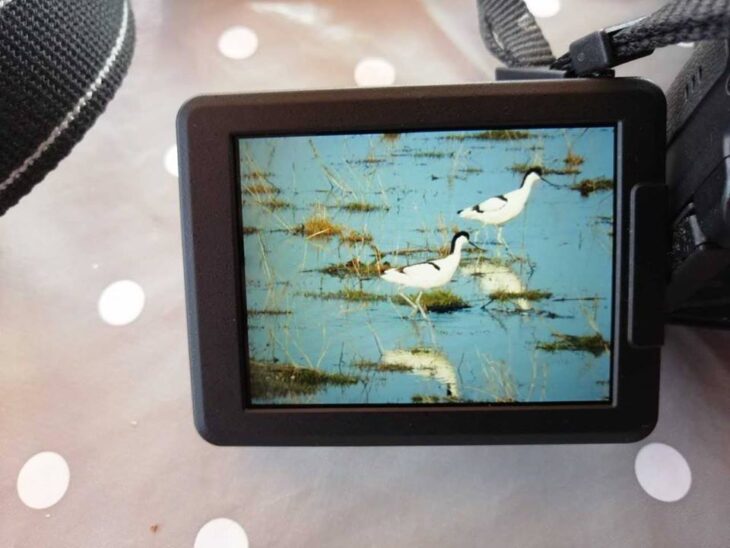
Owl of a Sudden – The Long-eared Owl
My personal favourite sighting is not, by any means, the rarest or the most notable. Neither is it the most colourful or the most exotic, but it has a special significance for me.
In February last year as light flakes of snow began to fall, we were scanning the foreshore and checking the garden birds as usual when all the sparrows darted into the bushes and blackbirds began making loud alarm calls. We started looking for the source of all the commotion – maybe a sparrowhawk – when an eagle-eyed member spotted a long-eared owl snoozing peacefully in one of the bushes only yards from the windows.
It was very well camouflaged amongst the bare branches and dead leaves and may have easily been overlooked had it not been for the alarm calls. This was my first, and so far, only sighting of a long-eared owl and it caused a lot of excitement in the Visitor Centre. Our Visitor Centre Assistant Manager, Joanna, even delayed a cinema trip during her day off to make sure she saw the nocturnal newcomer!

Not to be Glossed Over – The Glossy Ibis
In May 2016, we were graced by a scarce visitor – a glossy ibis. Only 80 birds are recorded each year in the UK and these are usually in the southern reaches of the UK. A few make it further and glossy ibises have turned up in the Outer Hebrides, Orkney and Shetland.
With the body and bill of a curlew and the legs of a flamingo, the glossy ibis gets its name from the amazing iridescent sheen of its wings. Its Latin scientific name Plegadis falcinellus, is derived from the Ancient Greek and Latin which both mean ‘sickle’. The glossy ibis sighting was a favourite of many birdwatchers, who travelled from miles around to try to capture the exotic visitor and its beautiful plumage.
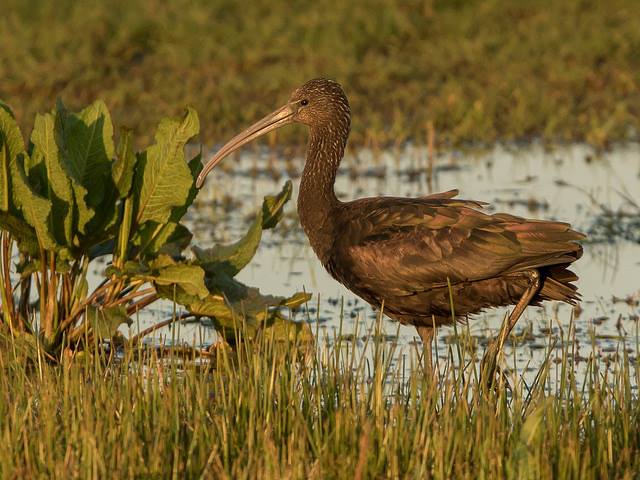
Just a Bit of Excitement – The Bittern
Also in 2016, in January and February, we were blessed by the presence of a very scarce winter visitor – a Bittern. Anna Cowie, our ranger, said “I found myself unable to take my eyes off it on those rare, special moments when it came out into the open in the salt pans area. Checking the scope for any hint of movement in the reeds where it may be hiding became a ritual when I started my day – ‘What a fantastic place to work!’, I thought every morning.”
The Bank of Scotland hide located at the bottom of the Visitor Centre car park was a hive of activity every day as people heard the news that travelled across the birding community and came in hope from far afield. Many were lucky and saw the Bittern out in the open, crossing the pools of the salt pans and foraging for food, others saw a glimpse of it perfectly camouflaged in the reeds. According to the 2007 edition of Birds of Scotland (known in the Montrose Basin ranger office as ‘the book with all the answers’) between 2 and 10 Bitterns were recorded annually in Scotland between 1990 and 2004 with 85% of sightings between October and March and peaking in January. Though it is acknowledged that these birds may go undetected due to their evasive nature, we still all felt thrilled to be observing bittern behaviour so regularly.
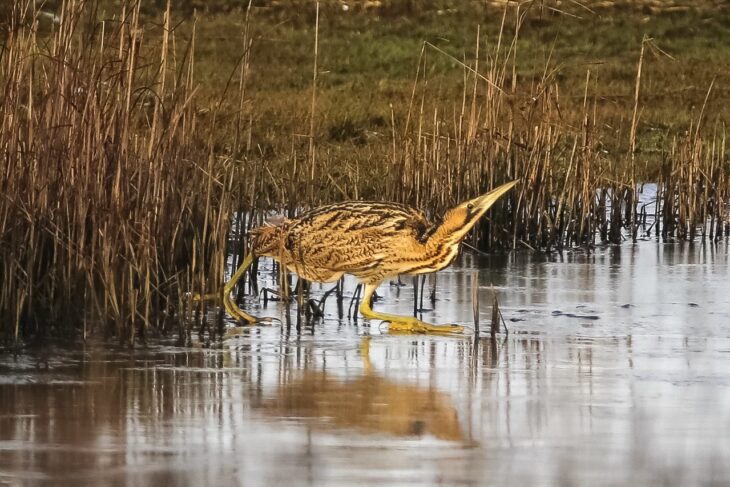
Seeing Pink – The…Chilean Flamingo?!
We’ll finish with a very ‘tropical’ rarity from our Lead Teacher Naturalist, Alison O’Hara. In 1997, she remembers taking a walk with her children along the Lurgies area of the reserve and telling them that a Chilean flamingo had been spotted in the area and they should keep their eyes peeled. A couple of minutes later, her young daughter said “What Mummy? Like that pink bird over there?” The ranger at the time, Rick Goater, said “it’s obviously an escapee…they have been seen in other wetland areas and although the eider ducks are not taking too kindly to it, it seems unperturbed.” We haven’t had such a vibrant visitor since!
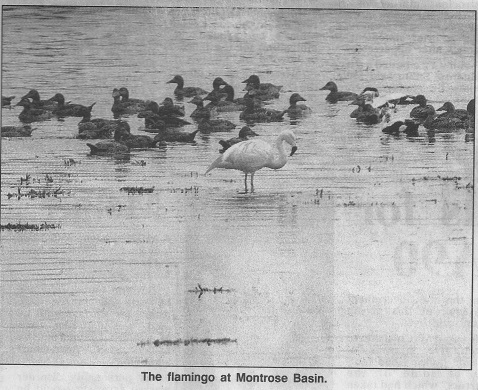
Of course these are just a selection of birds that we’ve been lucky enough to spot at Montrose Basin and it’s difficult to know how many or which species may have eluded us. Some, like the bittern and long-eared owl, are so well camouflaged that they can remain undetected in the dense reed beds of the reserve. Other sightings, like the hoopoe and glossy ibis, depend on prevailing wind patterns or individual birds misreading their migration clues to end up so far from their intended destinations.
While writing this, we’ve had so many suggestions of other rarities to include from volunteers and staff. It just goes to show you what an amazing place Montrose Basin is to work – there were too many exciting stories to include in just one blog! Other very notable rarities include: ivory gull, lesser yellowlegs, long-billed dowitcher, American wigeon, rose-coloured starling, Temminck’s stint, firecrest, spoonbills, ruddy shelducks and great white egrets. All in all you just never know what you might see at Montrose Basin Wildlife Reserve and you could be the next person to spot our next rarity!
Rachel Mackay-Austin
Seasonal Visitor Centre Assistant
Help protect Scotland’s wildlife
Our work to save Scotland’s wildlife is made possible thanks to the generosity of our members and supporters.
Join today from just £3 a month to help protect the species you love.
Preface
It’s a question we’re often asked at Montrose Basin Visitor Centre and not one that’s easy to answer – it’s affected by the passage of time, the location, and seasons. …
